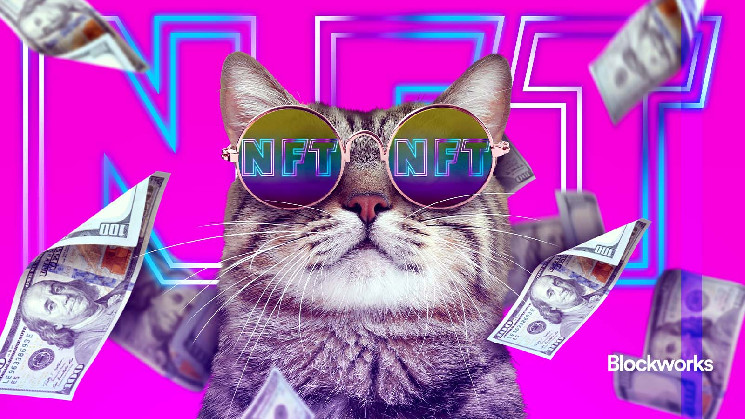This is a segment from the 0xResearch newsletter. To read full editions, subscribe.
The total NFT market cap today is about $3.6 billion, down hugely from its heady 2022 peaks.
Speculative NFT markets are dead, but the use cases of NFTs are not.
Non-fungible tokens as a data format and a unique digital identifier, in the technical sense, continue to be used in productive, non-speculative ways that do not necessarily translate to a number-go-up chart.
Take podcasts for instance. Pods.media provides podcasters a way to easily tap into an alternative monetization stream by letting fans mint NFTs of their podcast episodes. Users mint their favorite podcast NFTs for reasons of altruism, or just because it’s no big deal to pick up a one-time free digital collectible.
Since launching a year ago, Pods has onboarded 75+ podcasts and racked up more than $1 million in podcast episode mints across 120,000 collectors.
One of Pods’ biggest podcasts on its platform, Mint Podcast, has seen 250k+ NFTs minted across 69,789 unique collectors. Mint Podcast has raised about $476,885 in sales since it started using Pods in April 2024.
$477k is not life-changing money, but it’s a tidy sum for a little-known podcast in an industry where there’s an oversaturated podcasting supply side.
But the real use case of NFTs there goes beyond a simple revenue stream.
Having pushed his podcast audience towards a simple NFT mint with Pods, Adam Levy, the face behind Mint Podcast, was able to construct a comprehensive social graph of his anonymous audience.
To create a granular onchain composition, Levy targeted his 90k-strong audience with the use of Bello. The Web3 marketing analytics product, which he co-founded, spawned out of a hackathon at ETH Amsterdam.
“I learned that a high percentage of my onchain audience were also Zora collectors. With that information, I was able to tap the interests of my podcast listeners (with Bello) based on their wallet onchain’s history,” Levy tells Blockworks.
“I took action by doing more Zora-centric podcast episodes, which translated to another 40-50% more downloads on podcast content.”
In effect, NFTs enabled Levy to meet his users where they were once they took the first step of minting an episode.
As opposed to sending generic mass emails, Levy’s strategy enables the tailored outreach to podcast audiences who were active Lens or Farcaster users, directly in their social media DMs, or Coinbase Wallet users through the XMTP messaging protocol.
It also allows podcasters to curate their podcast content or sponsorships around trending content being minted in real time.
Picture having the hard evidence that 80% of your dedicated podcast audience interacted with a certain DeFi or NFT contract in the last six hours. Then imagine pushing out a podcast episode or marketing message crafted around that very topic in the very next hour.
It’s a plethora of onchain information that would not have been possible for any traditional podcaster using Spotify or Apple Music, Levy said.
“I don’t really care about my reach on Twitter or my audience on Instagram any longer — I care more about the wallets that collect my content because now I have ways to engage them in a permissionless manner where I can never be shadowbanned across any platform.”
Aside from podcasting, NFTs have also been used to fight counterfeit and fraud in the luxury goods sector.
Since 2021, the Geneva-based non-profit Aura consortium gives luxury brands a way to offer consumers an easy way to trace a product’s lifecycle and authenticate products onchain with NFTs.
It’s a purely non-speculative use case applying the immutable properties of NFTs to combat hundreds of millions of dollars worth of fraud and counterfeit in a $300 billion dollar industry.
Aura has brought onchain more than 50 million luxury goods from luxury watches, suitcases, shoes, cars, jewelry and furniture for over 50 luxury brands from the likes of Cartier, Dior, Prada, Mercedes-Benz and more.
Brands pay Aura licensing fees to use either a private or public blockchain option, though 90% opt for the former for data security and privacy reasons.
Traceability represents one of the big challenges in the luxury industry, in part due to laws like the EU’s Ecodesign for Sustainable Products Regulation (ESPR) and France’s Anti-Waste for a Circular Economy (AGEC) that put more scrutiny on a product’s lifecycle, Romain Carrere, CEO of Aura Blockchain Consortium told Blockworks.
There are countless other cases of NFTs being used for productive purposes, like unlocking new revenue streams for adult creators by MintStars, or raising funds and codifying intellectual property for niche science projects by Bio, as I’ve written previously.
More on this in a future 0xResearch edition.


